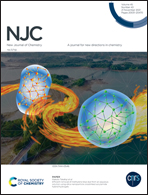Fabrication of a Ti3C2Tx modified glassy carbon electrode for the sensitive electrochemical detection of quercetin†
Abstract
In this study, two-dimensional MXene Ti3C2Tx was modified on a glassy carbon electrode (GCE) to improve its performance for electrochemical detection. The morphology and structure of Ti3C2Tx were characterized by SEM and TEM. A new modified electrode was then fabricated by coating MXene solution on GCE for quercetin detection. The performance of MXene/GCE was determined by various methods, which showed an enhanced electrochemical activity. Direct electrochemistry of quercetin was investigated, and a pair of well-shaped redox peaks appeared with a peak-to-peak separation of 67 mV. The detection of quercetin by this proposed electrode was studied in detail, and presented a lower detection limit of 33 nM (3S0/S) with electrochemical parameters such as the electron transfer number (n), electron transfer coefficient (α) and reaction rate constant (ks) calculated as 1.99, 0.65 and 0.29 s−1, respectively. MXene/GCE was successfully utilized for the analysis of quercetin content in Ginkgo tablet samples with recoveries from 100.92% to 104.66%. Besides, MXene/GCE showed good anti-interference performance, good stability and reproducibility for the detection of quercetin.



 Please wait while we load your content...
Please wait while we load your content...